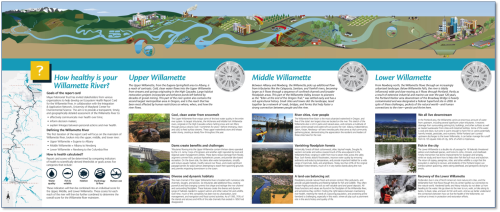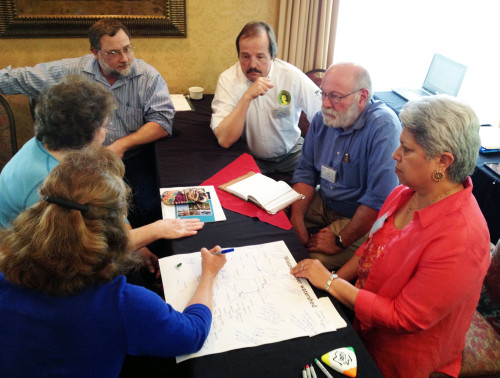Collective impact and ecosystem health report cards: The product enables the process
Heath Kelsey ·This is the second of two Blogs about the intersection of the Collective Impact approach and ecosystem health report cards. In Part 1, I discuss the principles of collective impact, and how our report card process can be a catalyst for engagement. Part 2 discusses two examples of this process, the first, in the Willamette River, Oregon, uses the report card development process expressly as a part of a deliberate collective impact approach, and the other, for the Mississippi River, collective impact principles, without explicitly following the model.
The Willamette River Report Card
In 2013, Bill Dennison introduced me to Pam Wiley, Meyer Memorial Trust’s Willamette River Initiative Manager, at Riversymposium in Brisbane, Australia, where she had just received the International River Prize on behalf of the Trust. We started talking report cards, especially how they seemed to become focal points and catalysts for people to come together for a common purpose. Either she didn’t mention this explicitly, or out of ignorance it didn’t sink in with me, but Pam and the Trust were already thinking in terms of collective impact approaches. In fact, Pam had written a paper [pdf] on how to incorporate this approach for restoration on large river ecosystems. The trust had put a lot of thought into the collaborative strategies that funders could use to best collaboratively fund parts of the initiative, and the report card idea presented a concrete product that would galvanize stakeholder engagement.![The Willamette Funding Partnership. Figure by Cristina Watson/Meyer Memorial Trust from Wiley et al 2013 [pdf] The Willamette Funding Partnership. Figure by Cristina Watson/Meyer Memorial Trust from Wiley et al 2013 [pdf]](/site/assets/files/2433/funding-network-edit-feb18-2015-500x386.png)
The idea of a report card as a touchstone for collective impact in the Willamette seemed to resonate strongly with Pam. We kept talking about it and began the Willamette River Report Card project in mid-2014. For this project we designed four on-site visits: one as an introduction to many of the partners and participants, the second to conduct the first workshop (Steps 1, 2, and 3 of the report card process, and beginning Steps 4 and 5), the third to present the draft at the Within Our Reach Conference, and the fourth to present the near final result. We’re now nearing the final stages, getting ready for the fourth visit to present the results.

I’ve been particularly impressed with the group’s willingness and ability to work together for this common vision. Obviously, the level of trust generated by years of work on the part of the Trust has paid big dividends. The report card process has supported this by allowing the participants to focus their efforts and collaboration on something concrete. It also has helped facilitate the further development of trust among participants, clarification of a shared vision, common measurements, and continuous communication – all essential components of the collective impact process.
The Mississippi River Report Card
The Mississippi River Report Card is the most complex and broadly scoped report card project we’ve undertaken at IAN. The report card seeks to identify and measure indicators that reflect on six broad goals established through a stakeholder consultation process. The six goals include:
- Provide world class recreation opportunities
- Provide reliable flood control and risk reduction
- Maintain supply of clean abundant water
- Support and enhance healthy and productive ecosystems
- Support local, state, and national economies, and
- Serve as the nations most important water transportation corridor.
IAN has been working on the Mississippi Report Card Project since 2013, to identify the most important values within each goal area in each of the 5 major basins of the Mississippi River watershed: the Upper Mississippi River, the Ohio River, the Lower Mississippi River, the Arkansas and Red Rivers, and the Missouri River basins.

The 5-steps of the report card process were engaged in 2-day workshops at each of these basins in 2013 – 2014. The workshops included high-level participation from multiple stakeholders with the goal of establishing consensus on values and indicators used to measure their status. At the end of each workshop, a newsletter was produced, which documented the progress we made, decisions we reached about the key messages, and the indicators we could use to measure progress toward the goals.

Our intent for the workshops was originally very simple: to identify the measures that would be appropriate for each goal and region. We were seeking expert opinion and local knowledge to select the indicators that mattered most. However, it quickly became apparent that the workshops created value beyond that narrow objective. The workshop participants routinely mentioned how unusual and refreshing it was to work together with other stakeholders, sometimes with perspectives very different than their own. The single-issue advocacy model that interest groups have been following for decades has precluded this level of collaboration until now.
The workshop itself, the newsletters, and the report card as the ultimate product, provided rallying points for working together. A common vision, common measurements for progress, a common language, and perhaps a new level of trust among the participants began to emerge. Although this process has been ongoing for a few years now, the term Collective Impact was unknown to us. It is reassuring to know that others have recognized the value we see in this process.
About the author
Heath Kelsey

Heath Kelsey has been with IAN since 2009, as a Science Integrator, Program Manager, and as Director since 2019. His work focuses on helping communities become more engaged in socio-environmental decision making. He has over 15-years of experience in stakeholder engagement, environmental and public health assessment, indicator development, and science communication. He has led numerous ecosystem health and socio-environmental health report card projects globally, in Australia, India, the South Pacific, Africa, and throughout the US. Dr. Kelsey received his MSPH (2000) and PhD (2006) from The University of South Carolina Arnold School of Public Health. He is a graduate of St Mary’s College of Maryland (1988), and was a Peace Corps Volunteer in Papua New Guinea from 1995-1998.

